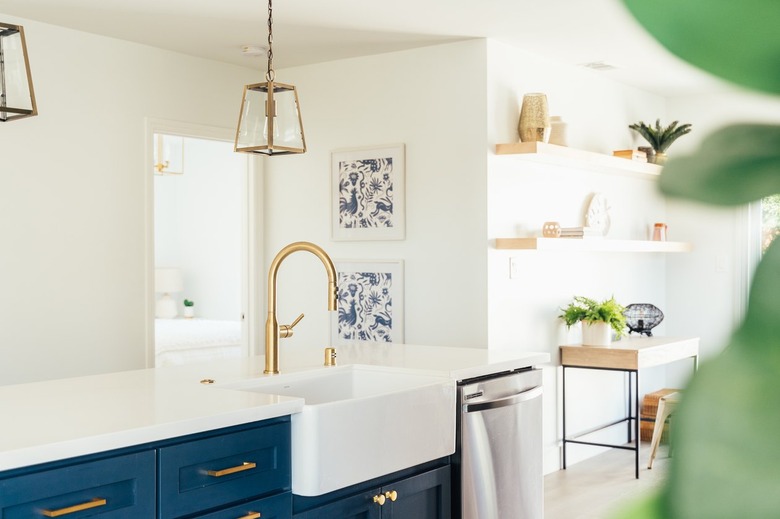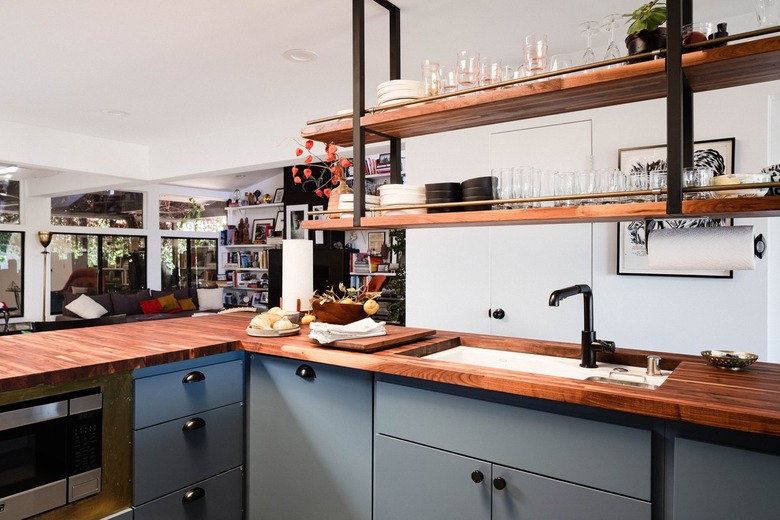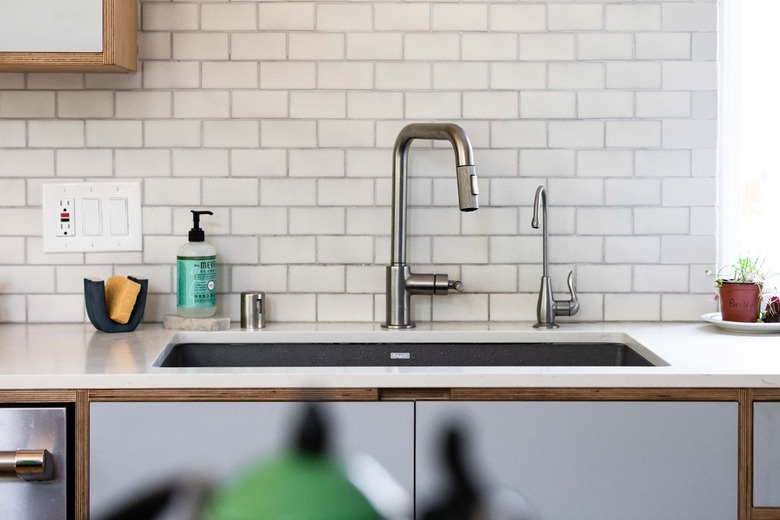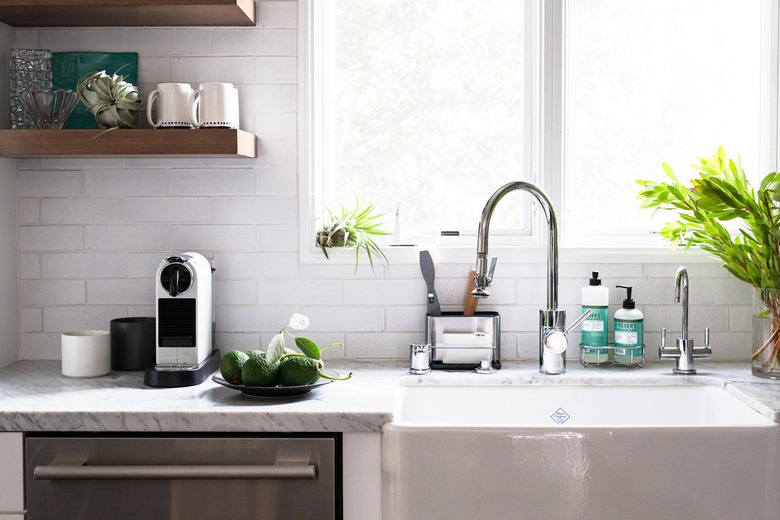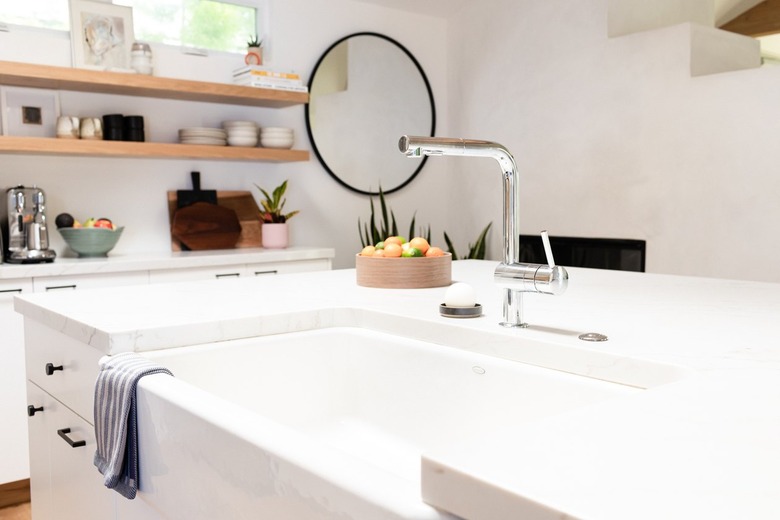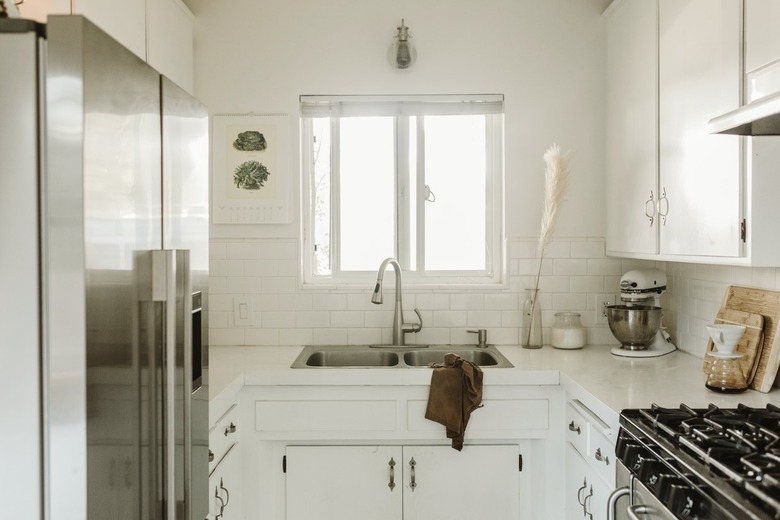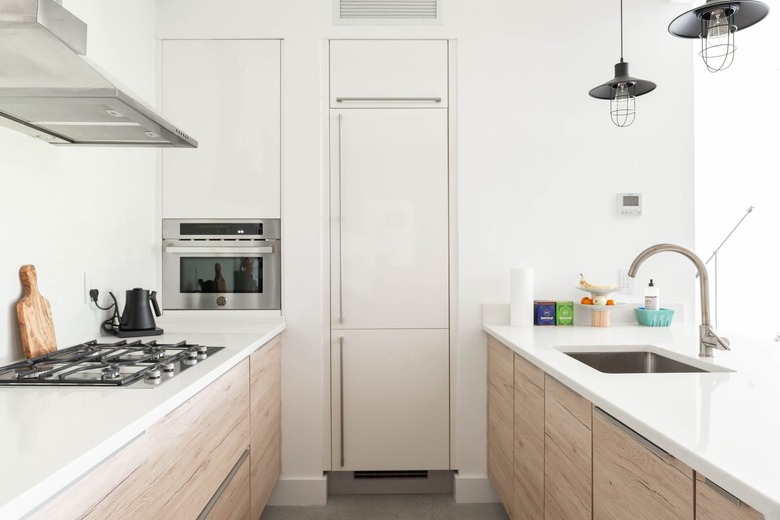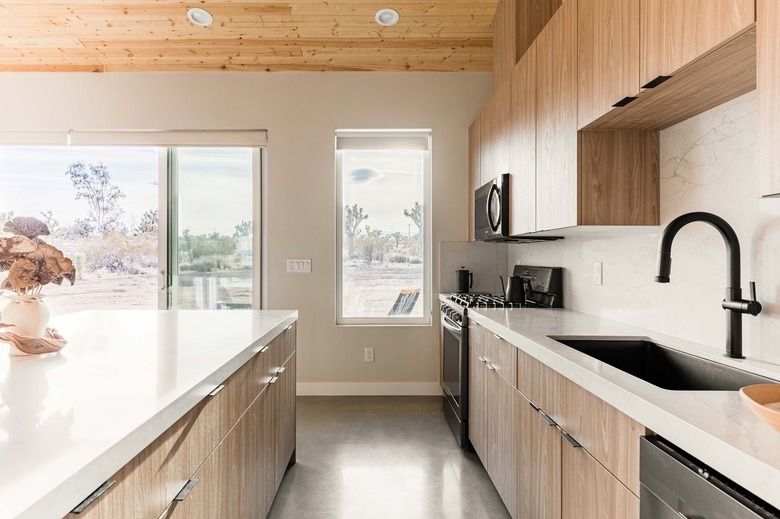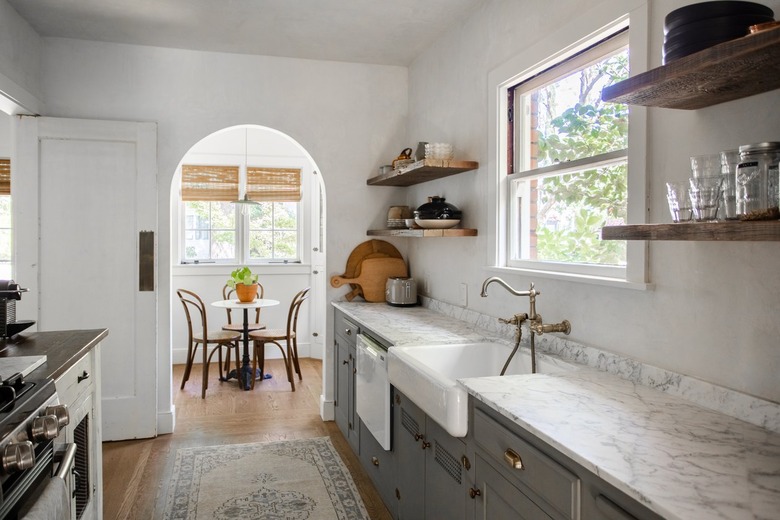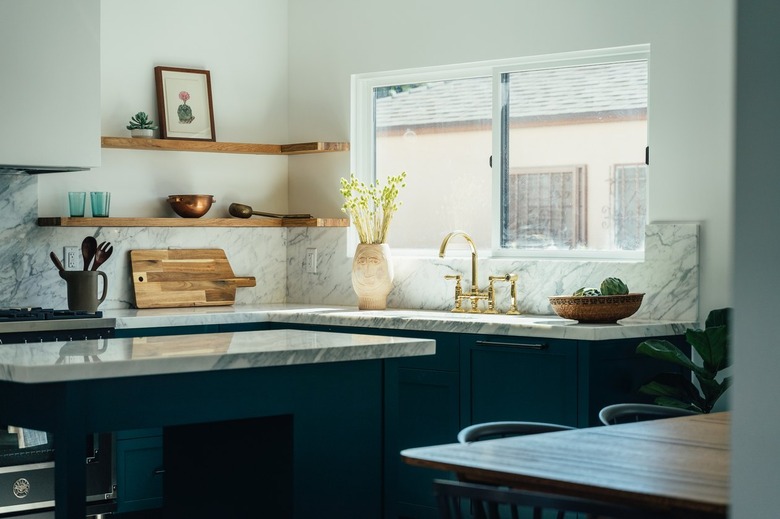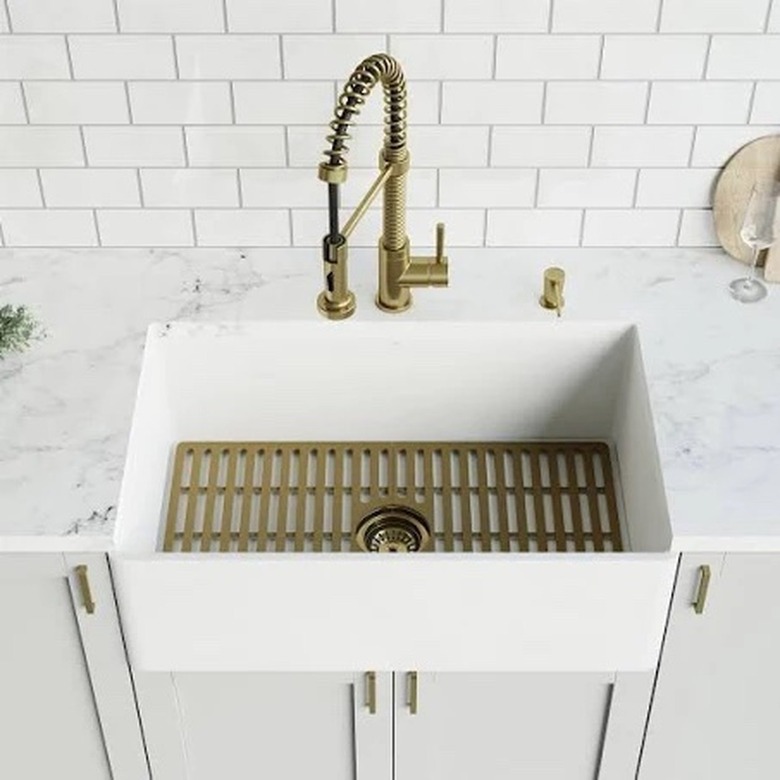12 Things To Consider Before Buying Your Dream Kitchen Sink
We may receive a commission on purchases made from links.
Are you tired of the same old stainless steel kitchen sink you've been washing dishes in for years? Upgrading your kitchen sink, whether it's a solo project or part of a larger kitchen renovation, gives the space a fresh look. It also needs to handle the heavy lifting for things like washing greasy casserole dishes, prepping family meals, and filling large pots with water. Looking at various sink features and installation considerations helps you choose the right kitchen sink for your needs.
1. Current Cabinet Configuration
1. Current Cabinet Configuration
If you're replacing your current sink and keeping the existing kitchen cabinets, the condition of those cabinets can have an impact on the sink selection and scope of the project. For example, fireclay and cast iron kitchen sinks are very heavy and might require additional reinforcements if your current cabinets aren't up to the challenge. The cabinets also need to have room for the width and depth of the new sink.
If you're switching from a traditional sink to a farmhouse sink with an apron front, you'll also need to modify the cabinets. The farmhouse sink installation process involves cutting the cabinets to accommodate the sink apron. Hiring a contractor to handle these cabinetry modifications adds to the project cost and extends the project timeline.
2. Kitchen Sink Style
2. Kitchen Sink Style
The practical functions of a sink are paramount, but it is also a key piece in your kitchen aesthetics, so sink style is an important factor. Undermount sinks offer a smooth, sleek, updated look and offer the greatest amount of countertop space, while drop-in sinks offer a more traditional sink aesthetic. An apron-front sink is often a staple in a farmhouse-style kitchen, but you can also find sinks with sleek stainless steel aprons that fit a modern kitchen or a concrete apron sink for industrial-style kitchens.
If you want a statement sink as part of your dream kitchen, standout kitchen sink materials, like natural stone and copper, make the sink the star of the space. Copper changes over time with its living finish that develops a patina, so your kitchen sink looks different the longer you have it. Material also affects the color options, with enameled and fireclay sinks offering a wide range of colors. Choosing a bold-colored sink is another way to make a statement in your kitchen. Natural stone and stone composite materials generally offer a more natural color selection with some dark colors to add a dramatic tone.
3. Kitchen Sink Sizing
3. Kitchen Sink Sizing
When choosing a kitchen sink, consider the size your kitchen can accommodate. If you're replacing an existing sink, using the same type and size is the easiest option with few if any modifications or adjustments being necessary. If you're doing a total renovation, consider the overall kitchen size. A tiny sink will get swallowed up in a spacious kitchen, while a massive farmhouse sink with a prominent apron will overwhelm a cozy little kitchen.
How you use the sink can also affect the ideal kitchen sink size. If you spend lots of time cooking or baking, you'll likely have lots of dishes. A large, deep sink makes it easier to keep up with all those dirty dishes. If you rarely cook, a smaller sink is sufficient and frees up more counter space for takeout food containers.
4. Kitchen Sink Depth
4. Kitchen Sink Depth
Along with the length and width of the sink, the depth affects the functionality and aesthetics of the kitchen sink. Deep sinks accommodate larger pots, but they can also be difficult to use for shorter or taller homeowners who can't comfortably reach the bottom of the sink. Accessibility can also be an issue for someone in a wheelchair if the kitchen sink is deep. A deep kitchen sink also extends deep into the sink base cabinet, leaving less space below for storage, particularly if there's a garbage disposal installed.
5. Kitchen Sink Configuration
5. Kitchen Sink Configuration
Sink configurations are another consideration when installing a new sink, with options including one, two, or three bowls. Think about how you use your sink to determine which configuration works best in your kitchen. A deep, single-bowl sink is ideal for washing or filling large pots. For hand-washing dishes, a double-bowl sink is sometimes better so you can use one side for washing and the other for rinsing. If most of your dishes go into the dishwasher, a single-bowl sink should work well.
Double-basin sinks traditionally feature two equally sized bowls with a divider in the middle. Modern designs often include two different sizes for the bowls: one that's oversized and one that's smaller or standard size. This gives you more space like you get with a single-bowl sink while still offering two separate areas.
While not as common, triple-bowl sinks are also available. Expect them to take up more of your counter space since they're generally larger to accommodate the three basins. The third bowl is often much smaller, making it ideal as a prep sink. However, the sizing between the three bowls can vary, including having two large bowls with a small bowl or three different sizes.
6. Countertop Material Considerations
6. Countertop Material Considerations
Countertop material can affect whether you choose a drop-in or undermount sink. If you have laminate countertop, a drop-in sink is usually the best option. Undermount sinks are ideal when you have solid materials, like natural stone, quartz, or solid surface. Since the edge of the countertop is exposed with an undermount sink, you want a countertop material that has solid edges (not layered, like laminate) so it can stand up to water and have a finished look.
7. Sink Cleaning and Maintenance Requirements
7. Sink Cleaning and Maintenance Requirements
Every sink requires regular cleaning and maintenance, but some materials are more forgiving and are lower maintenance than others. Consider how careful you are when cleaning your sink and tossing dishes into it.
Common sink materials and corresponding cleaning needs include:
- Stainless steel sinks: A stainless steel sink resists scratches and dents, especially when you choose a lower (thicker) gauge, but it can develop water spots if you don't clean and dry it regularly. While it doesn't typically stain, it can scratch or dull over time.
- Granite composite sinks: Nonporous granite composite wipes clean easily for a low-maintenance option. It's also resistant to everyday damage, including scratching, chipping, and color changes.
- Fireclay sinks: Fireclay is also nonporous and has a glossy finish that makes cleaning easy. It's also resistant to scratching, chipping, and staining, but it can develop cracks in the glazing if you have a garbage disposal installed because of the vibrations.
- Copper sinks: Naturally anti-microbial copper cuts down on germs and gunk. You can seal the copper to slow or stop the patina from developing, but this cuts down on the anti-microbial effect. Acids and abrasive cleaners can strip the patina in patches, so it's best to avoid them. The patina will eventually darken in those areas.
- Enameled cast iron or steel sinks: The smooth, glossy porcelain surface on enameled sinks makes them easy to wipe clean. However, the brittle surface can chip or scratch if you're rough with the sink. You also need to avoid abrasive and acidic cleaners, which can damage the enamel finish.
- Acrylic sinks: Acrylic sinks don't hold up well against extreme heat, but they resist stains and rust. You can also sand and polish the surface lightly if it becomes scratched.
- Natural stone sinks: Because natural stone is porous, these sinks require regular sealing to keep them from staining and to make cleaning easier.
8. Ease of Cleaning Countertops
8. Ease of Cleaning Countertops
When comparing kitchen sink options, look at how the type affects overall kitchen cleaning. An undermount sink attaches beneath the countertop, eliminating the raised edges that you get with a drop-in sink, also called a top-mount sink. You can wipe the counter easily and push any excess water or crumbs into the sink with an undermount style.
A solid surface sink that's integrated into the countertop is another solid contender if you want easy cleanup. They offer a smooth, continuous surface with inconspicuous seams and a nonporous construction that makes cleaning simple.
9. Current Plumbing Arrangement
9. Current Plumbing Arrangement
It's easiest to choose a new kitchen sink that works with the kitchen sink plumbing that's already in place. If the current drain pipe and water supply configurations are usable, you don't need to worry about expensive adjustments to the plumbing to accommodate the new sink. Also consider current features, such as garbage disposals, water filters, and hot-water dispensers. If you plan to keep them, your new sink should easily fit into the space with those existing plumbing features.
10. Sink Drain Location
10. Sink Drain Location
It's easiest to choose a sink with the same drain placement, but if you're starting from scratch or willing to modify the plumbing, a different sink drain location might fit your preferences. Consider the various drain locations and their advantages:
- Center drains: This configuration is traditional. The drain is in the center of the sink, creating a shorter distance for the water to travel. However, large dishes can block the drain when you pile them in the sink.
- Offset drains: Set to the side, these drains provide more solid space to pile dishes without blocking the drain. It can also open up more under-sink space since the plumbing is off to the side. However, that can make the plumbing more difficult to work with.
- Rear drains: The rear drain configuration offers similar benefits and disadvantages as offset drains since it's pushed to the back of the sink.
11. Optional Sink Accessories
11. Optional Sink Accessories
Modern sinks can become multifunctional workstations with extra features. Bottom sink grids come with some sinks to keep heavy pots from hitting the bottom of the sink. Some workstation sinks have ridges along the top edge that hold a cutting board or drainboard that can help with food prep and cleanup. A built-in soap dispenser gives you easy access to dish soap and creates a streamlined look. Consider the extra features you want on your sink to narrow down the options that accommodate those sink accessories.
12. Kitchen Faucet Considerations
12. Kitchen Faucet Considerations
When choosing your kitchen sink, consider how the kitchen faucet will fit into the picture. If you have a particular faucet style or configuration in mind, your sink needs to accommodate that configuration. Kitchen sinks come with one to four holes, allowing for different combinations of faucets and accessories.
Some examples include:
- One hole: The sink can only accommodate a single kitchen faucet that requires only one hole. Two-handle faucets typically require three holes.
- Two holes: This configuration is usually designed for a single faucet and one accessory.
- Three holes: A three-hole sink typically works for two-handle faucets that require three holes. If you choose a single faucet with a deck plate, the plate might cover the extra holes if it's large enough.
- Four holes: With four holes, you can install a faucet requiring three holes plus an accessory or a single-hole faucet with multiple accessories.
Consider the kitchen design when choosing both the sink and the faucet. Choose a sink and faucet that go well together to create a sink area that looks beautiful and functions well.
